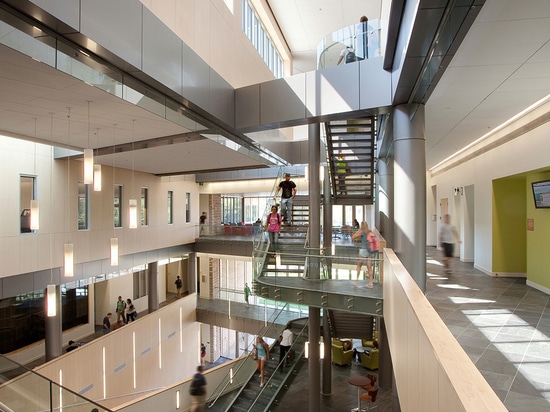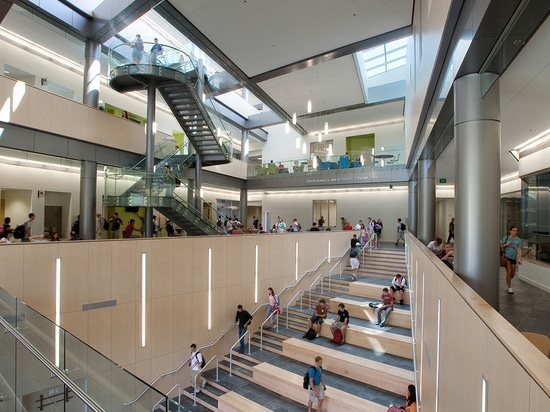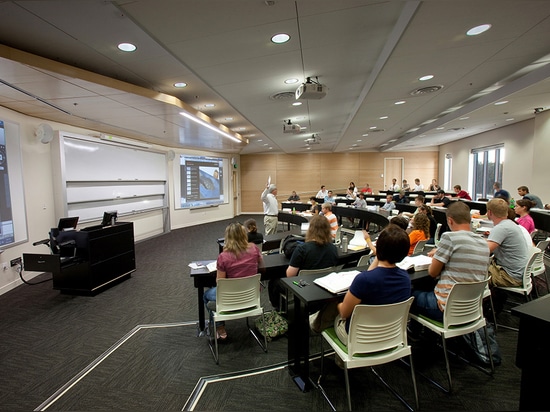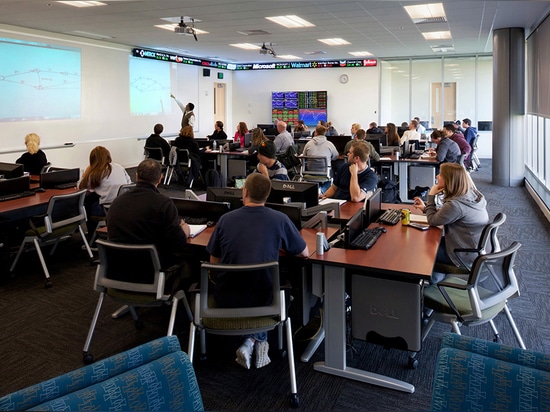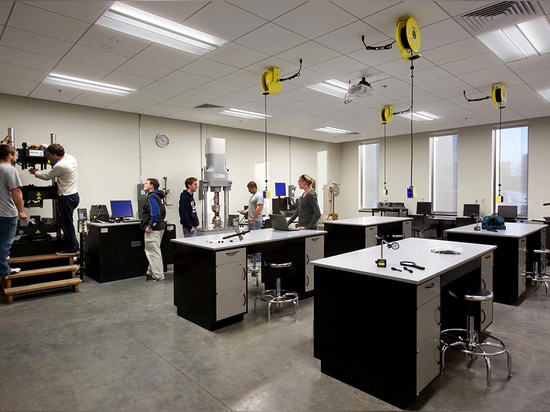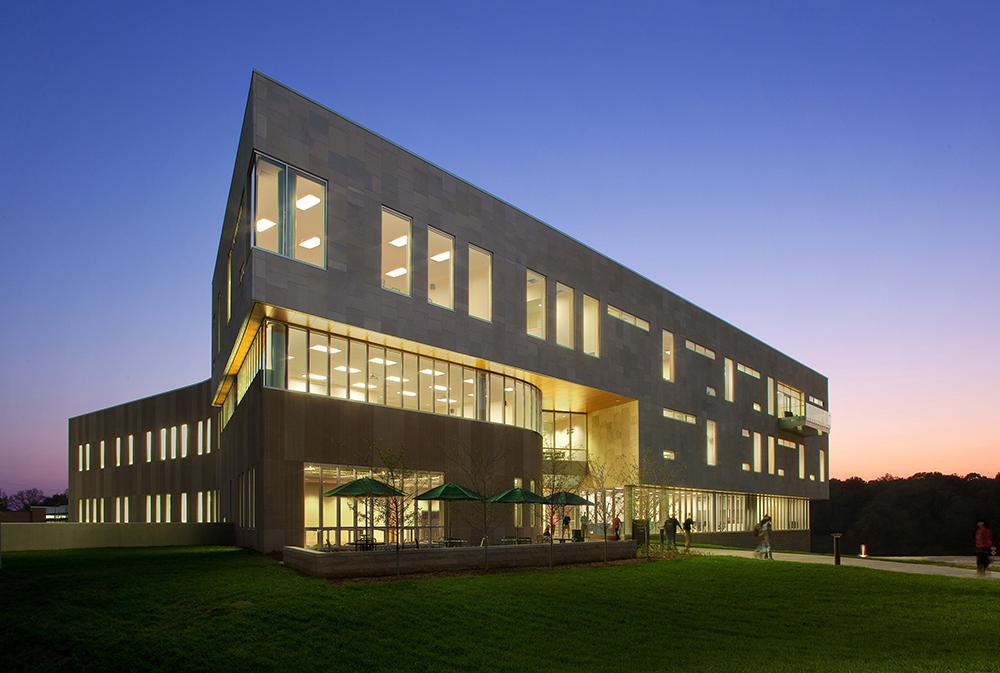
#PUBLIC ARCHITECTURE PROJECTS
University of Southern Indiana Business and Engineering Center
Architectural inspiration can take many forms, but in the case of the University of Indiana Schools of Business and Engineering designed by HOK with Hafer Associates, it is the fact of two schools coming together into one building
Each has their own formal and material expression, but more importantly the intersection between them is an atrium that is shared by both schools. HOK answered a few questions about the project.
Please provide an overview of the project.
HOK, in association with Hafer Architects were selected to design a new Business and Engineering Center at the University of Southern Indiana.
The new facility serves expanded enrollments in the Schools of Business and Engineering at both the undergraduate and graduate level and provides needed general classroom and specialized laboratory and instructional space, faculty and administrative offices, student study areas, computer laboratories, and group meeting facilities.
The general classroom space and specialized laboratories in the new facility are used to support academic requirements for the University’s engineering program and manufacturing technology program.
This classroom and laboratory building encourages cross-disciplinary innovation by serving both the business and engineering programs interdependently. The design provides dedicated classroom and laboratory space for each program, as well as a shared central atrium.
By constructing a multipurpose classroom building for the School of Business with shared general academic instructional space and specialized laboratories, the University gained economies of scale relative to both construction and subsequent operating costs.
What are the main ideas and inspirations influencing the design of the building?
The two central conceptual goals of the project were to reflect the synergy of the Business school and the School of Engineering and to reinforce the integrity of the main quadrangle in order to develop it as the heart of the campus.
The building was programmed to house both the Business and Engineering Schools, and to support their shared mission to promote the development of the idea-to-market path.
The design team’s sensibility overlapped with USI’s aspirations and allowed the team to establish seven clear design goals:
A strong sense of place
Distinct identities with a synergy
Highly visible collaborative spaces
Connect to the local business community
Foster guiding principles
Connect with the natural setting
Create a regional landmark
The two schools are represented by two intertwined building masses that form common space at the heart of the building to promote casual interaction. Building materials connect building to campus, in limestone/cast stone and buff masonry. Program volumes were defined by materials, with Engineering in masonry and Business in stone. Collaborative volumes were distinguished with glass while wood characterizes the atrium and represents community.
The building also fills a gap in the perimeter of the campus’s central quadrangle while the common spaces within the building connect the quad to an adjacent lake, another significant campus feature.
To what extent did the clients and/or future users of the building influence the design and the outcome of the building?
Leading programming, HOK used an iterative process based on understanding client needs through listening and through design dialogue. One of the keys to the success of this project was that USI had very clear aspirational needs and they were able to articulate those to the programming team in the initial interview with Deans and Administrators.
HOK helped USI identify the qualitative and quantitative needs for the building and its users. Utilizing HOK’S Problem Seeking Methodology, HOK started with the Kick-off and Visioning Session then led a series of programming interviews with the College of Business, Department of Engineering, College of Liberal Arts, the Registrar, and Physical Plant. These were followed by programming verification sessions with the College of Business and the Dept. of Engineering. Students participated in the process through a course assignment and were able to contribute their aspirations as well.
Following the initial interviews, priorities were aligned, a budget was established and a series of umbrella concepts were identified that captured USI’s academic and campus goals and organized our design thinking.
These included:
Create a community of innovation
Connect to local business
Connect to the USI community
Create an energetic place
Create a flexible building
Complete the quad
Celebrate the collaborative educational process
Once these concepts were identified, the team was able to seamlessly move into the design phase for the building.Were there any significant challenges that arose during the project? If so, how did you respond to them?
The primary challenge was in establishing a program that would allow cross-disciplinary innovation by serving both the business and engineering programs interdependently. This unique combination of programs allows for sharing of important skills and knowledge, highly valuable in today’s technological and entrepreneurial environments.
HOK responded with a design solution that provides dedicated classroom and laboratory space for each program, as well as a shared central atrium for collaboration. The University’s commitment to and enthusiasm for this unique collaboration of business and engineering as a catalyst for moving innovative products to market was the seed of the ultimate building form, and their long-term vision for the campus guided the contextual development of the quadrangle.
The design makes subtle use of a green roof to hide mechanical space below grade to the left of the entrance from the quadrangle.How does the building relate to contemporary architectural trends, be it sustainability, technology, etc.?
The facility meets or exceeds standards for green design and includes sustainable strategies such as:
Natural light illuminates the building through upper-level clerestory windows, skylights, and light wells
Motion sensors on lights
Light-colored roofing reduces the heat island effect and conserves energy
Approximately 20 percent of the materials used in construction were recycled or regionally-sourced
Architectural trends in education are reflected through the use of collaborative student space for study, and technology-rich learning spaces in classrooms equipped for distance learning. Learning spaces designed to support entrepreneurial spirit between business and engineering, such as the Entrepreneurship Laboratory, painted with IdeaPaint – a dry erase white board surface so students can write ideas on the walls. Desks on wheels can easily be moved into a wide variety of grouping arrangements.
How would you describe the architecture of Indiana and how does the building relate to it?
Indiana has a strong tradition of masonry construction in institutional settings, and is particularly noted for the quality of its limestone. This building takes advantage of this heritage by using unit masonry and limestone cladding as primary materials.
